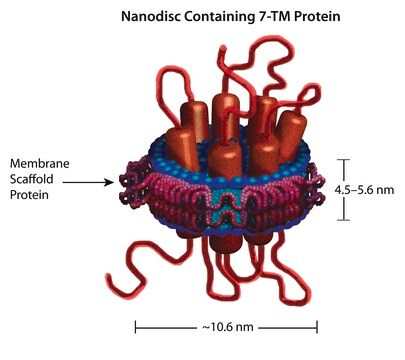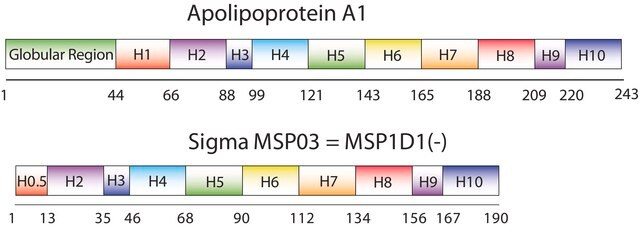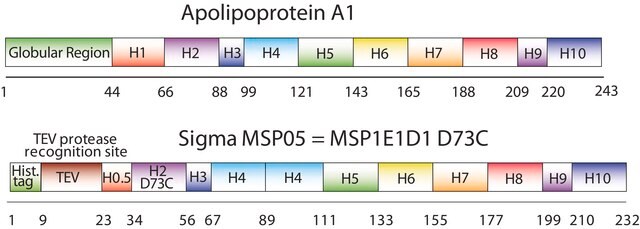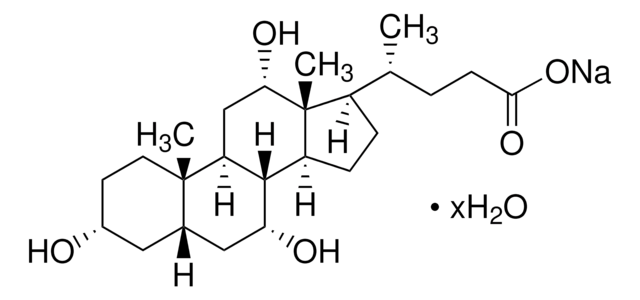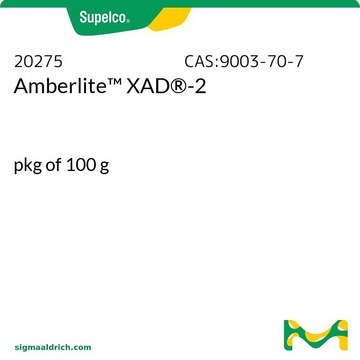おすすめの製品
詳細
Research area: Cell signaling. Nanodiscs are non-covalent structures that contain a phospholipidbilayer and a membrane scaffold protein (MSP), a genetically engineeredprotein, that mimics the function of Apolipoprotein A-1 (ApoA-1). The firstMSP, MSP1, was engineered with its sequence based on the sequence of A-1, butwithout the globular N-terminal domain of native A-1. The Membrane ScaffoldProtein 1D1 (MSP1D1) variant of MSP1 deletes the first 11 amino acids in theHelix 1 portion (referred to as “H0.5” in the accompanying figure) of theoriginal MSP1 sequence.It consists of an N-terminal histidine-tagged protein with a tobaccoetch virus (TEV) protease cleavage site that is present between the proteinsequence and histidine-tag.Nano-disctechnology is an approach that allows aqueous soluble membrane proteins in anative-like bilayer environment that enables the membrane proteins to remainactive and stable.
アプリケーション
このナノディスクシステムは、GPCR、P450、バクテリオロドプシン、凝固因子、コレラ毒素、TAR受容体、アロマターゼなどの多様なタンパク質の導入に活用されています。
ナノディスク可溶性脂質二重層システムは、膜タンパク質が単分散かつ活性を維持している天然様二重層環境の水溶液中で膜タンパク質を可溶性にするための手法として、広範に応用可能であることが示されています。ナノディスクの重要な成分は、encircling amphipathic helical protein belt(膜足場タンパク質)です。
引用およびプロトコールの全一覧については、Sligar Labのホームページsligarlab.life.uiuc.edu/nanodisc.htmlをご覧ください。
For guidelines on the use of this and other MSP′s to prepare Nanodiscs, please visit our Protocols for Membrane Scaffold Proteins and Nanodisc Formation page.
生物化学的/生理学的作用
直径約9.7 nmのナノディスクを生成します
MSP1D1 can self-assembleinto discoidal nanoparticles known as nano-discs. These nano-discs may be used inthe field of medicine, biotechnology, and membrane protein studies.
法的情報
ナノディスク技術、およびその使用の多くは、イリノイ大学保有の以下の特許の対象となっています。
- 7,691,414膜足場タンパク質
- 7,662,410膜足場タンパク質およびテザード膜タンパク質
- 7,622,437組織因子の構成および手法
- 7,592,008膜足場タンパク質
- 7,575,763膜足場タンパク質およびテザード膜タンパク質
- 7,083,958膜足場タンパク質
- 7,048,949膜足場タンパク質
Nanodisc technology, and many of its uses, are covered by the following patents held by the University of Illinois.
- 7,691,414 Membrane scaffold proteins
- 7,662,410 Membrane scaffold proteins and embedded membrane proteins
- 7,622,437 Tissue factor compositions and methods
- 7,592,008 Membrane scaffold proteins
- 7,575,763 Membrane scaffold proteins and tethered membrane proteins
- 7,083,958 Membrane scaffold proteins
- 7,048,949 Membrane scaffold proteins
保管分類コード
10 - Combustible liquids
WGK
WGK 2
引火点(°F)
Not applicable
引火点(℃)
Not applicable
適用法令
試験研究用途を考慮した関連法令を主に挙げております。化学物質以外については、一部の情報のみ提供しています。 製品を安全かつ合法的に使用することは、使用者の義務です。最新情報により修正される場合があります。WEBの反映には時間を要することがあるため、適宜SDSをご参照ください。
Jan Code
MSP01-5MG:
MSP01-VAR:
MSP01-BULK:
この製品を見ている人はこちらもチェック
Christopher I Cazzonelli et al.
eLife, 9 (2020-02-01)
Carotenoids are a core plastid component and yet their regulatory function during plastid biogenesis remains enigmatic. A unique carotenoid biosynthesis mutant, carotenoid chloroplast regulation 2 (ccr2), that has no prolamellar body (PLB) and normal PROTOCHLOROPHYLLIDE OXIDOREDUCTASE (POR) levels, was used
Benjamin J Cole et al.
PLoS biology, 15(9), e2002860-e2002860 (2017-09-25)
Diverse soil-resident bacteria can contribute to plant growth and health, but the molecular mechanisms enabling them to effectively colonize their plant hosts remain poorly understood. We used randomly barcoded transposon mutagenesis sequencing (RB-TnSeq) in Pseudomonas simiae, a model root-colonizing bacterium
Yan Bao et al.
Autophagy, 14(9), 1562-1573 (2018-06-27)
Macroautophagy/autophagy is a conserved process in eukaryotes that contributes to cell survival in response to stress. Previously, we found that endoplasmic reticulum (ER) stress induces autophagy in plants via a pathway dependent upon AT5G24360/IRE1B (INOSITOL REQUIRING 1-1), an ER membrane-anchored
Ping Wang et al.
Autophagy, 16(1), 123-139 (2019-03-27)
Autophagy is a conserved catabolic process in eukaryotes that contributes to cell survival in response to multiple stresses and is important for organism fitness. In Arabidopsis thaliana, the core machinery of autophagy is well defined, but its transcriptional regulation is
プロトコル
Protocols for Membrane Scaffold Proteins and Nanodisc Formation
ライフサイエンス、有機合成、材料科学、クロマトグラフィー、分析など、あらゆる分野の研究に経験のあるメンバーがおります。.
製品に関するお問い合わせはこちら(テクニカルサービス)

